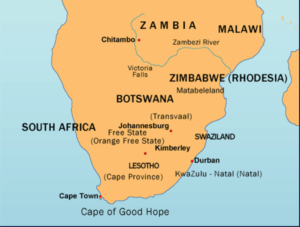 Jews have been a part of South Africa’s development from the very beginning. Portuguese Jewish cartographers and scientists contributed to Vasco Da Gama’s discovery of the Cape of Good Hope in 1497. A number of non-professing Jews were among the first settlers of Cape Town in 1652, despite restrictions against the immigration of non-Christians. In that year, the Dutch East India Company began the first permanent European settlement of South Africa under Jan van Riebeeck.
Jews have been a part of South Africa’s development from the very beginning. Portuguese Jewish cartographers and scientists contributed to Vasco Da Gama’s discovery of the Cape of Good Hope in 1497. A number of non-professing Jews were among the first settlers of Cape Town in 1652, despite restrictions against the immigration of non-Christians. In that year, the Dutch East India Company began the first permanent European settlement of South Africa under Jan van Riebeeck.
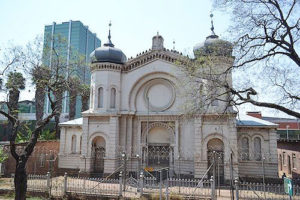 There were Jews among the directors of the Dutch East India Company, which for 150 years administered the colony at the Cape of Good Hope. During the seventeenth and the greater part of the 18th century the state religion alone was allowed to be publicly observed; but on 25 July 1804, the Dutch commissioner-general Jacob Abraham de Mist, instituted in the colony religious equality for all persons, irrespective of creed. This was annulled at the English occupation of 1806 and were not reestablished till 1820.
There were Jews among the directors of the Dutch East India Company, which for 150 years administered the colony at the Cape of Good Hope. During the seventeenth and the greater part of the 18th century the state religion alone was allowed to be publicly observed; but on 25 July 1804, the Dutch commissioner-general Jacob Abraham de Mist, instituted in the colony religious equality for all persons, irrespective of creed. This was annulled at the English occupation of 1806 and were not reestablished till 1820.
After the British occupation of the Cape in 1806, a steady flow of Jewish immigrants came from Central Europe and England and Eastern Europe. Jews did not arrive in any significant numbers at Cape Town before the 1820s. The first congregation in South Africa, known as the Gardens Shul, was founded in Cape Town in September 1841 and the first synagogue, built in about 1863. For many years, Cape Town was the principal centre of Jewish communal life in South Africa. The Mosenthal brothers: Julius, Adolph, and James Mosenthal bought thirty Angora goats in 1856 they became the originators of the mohair industry.
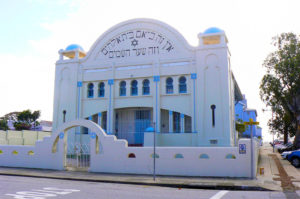 Aaron and Daniel de Pass were the first to open up Namaqualand, and from 1849 to 1886 they were the largest shipowners in Cape Town, and leaders of the sealing, whaling, and fishing industries. Jews were among the first to take to ostrich-farming and played a role in the early diamond industry. The South African gold rush began after 1886, attracting many Jews. In 1880, the Jewish population of South Africa numbered approximately 4,000; by 1914 it had grown to more than 40,000. So many of them came from Lithuania that some referred to the population as a colony of Lithuania; Johannesburg was also occasionally called “Jewburg”. For many years, Cape Town was the principal centre of Jewish communal life in South Africa. With the discovery of diamonds in Kimberley and the rise of the Witwatersrand gold fields, however, there was a northward shift in the population, which played an active role in the development of trade and industry in the country.
Aaron and Daniel de Pass were the first to open up Namaqualand, and from 1849 to 1886 they were the largest shipowners in Cape Town, and leaders of the sealing, whaling, and fishing industries. Jews were among the first to take to ostrich-farming and played a role in the early diamond industry. The South African gold rush began after 1886, attracting many Jews. In 1880, the Jewish population of South Africa numbered approximately 4,000; by 1914 it had grown to more than 40,000. So many of them came from Lithuania that some referred to the population as a colony of Lithuania; Johannesburg was also occasionally called “Jewburg”. For many years, Cape Town was the principal centre of Jewish communal life in South Africa. With the discovery of diamonds in Kimberley and the rise of the Witwatersrand gold fields, however, there was a northward shift in the population, which played an active role in the development of trade and industry in the country.
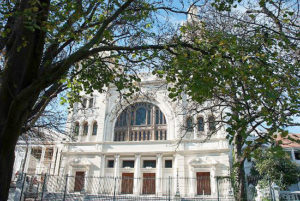 In 1904, the Cape Jewish Board of Deputies was formed at Cape Town, a year after the corresponding body was created for the Transvaal and Natal. The first congregation in Johannesburg (the Witwatersrand Old Hebrew Congregation) was formed in 1887 and the first synagogue built in 1888. Like Cape Town, Johannesburg also boasts a number of schools and other Jewish infrastructure including synagogues and aged homes.
In 1904, the Cape Jewish Board of Deputies was formed at Cape Town, a year after the corresponding body was created for the Transvaal and Natal. The first congregation in Johannesburg (the Witwatersrand Old Hebrew Congregation) was formed in 1887 and the first synagogue built in 1888. Like Cape Town, Johannesburg also boasts a number of schools and other Jewish infrastructure including synagogues and aged homes.
Although the Jews were allowed equal rights after the Boer War (1899–1902), they again became subject to persecution in the days leading up to World War II. In 1930, the Quota Act of 1930 was intended to curtail the entry of Jews into South Africa. The vast majority of Jews immigrating to South Africa came from diaspora communities in Lithuania. The 1937 The Aliens Act, motivated by a sharp increase the previous year in the number of German Jewish refugees coming to South Africa, brought the migration to almost a complete halt. Some Jews were able to enter the country, but many were unable to do so. A total of approximately 6,500 Jews came to South Africa from Germany between the years 1933 and 1939.
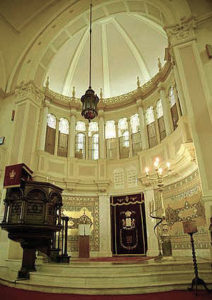 The Jewish community in South Africa is currently the largest in Africa, and, although shrinking due to emigration, it remains one of the most nominally Orthodox communities in the world, although there is a significantly growing Progressive community, especially in Cape Town. During this time, there were also two waves of Jewish immigration to Africa from the island of Rhodes, first in the 1900s and then after 1960. In Johannesburg, the largest centre of Jewish life, there is a high number and density of kosher restaurants and religious centres.
The Jewish community in South Africa is currently the largest in Africa, and, although shrinking due to emigration, it remains one of the most nominally Orthodox communities in the world, although there is a significantly growing Progressive community, especially in Cape Town. During this time, there were also two waves of Jewish immigration to Africa from the island of Rhodes, first in the 1900s and then after 1960. In Johannesburg, the largest centre of Jewish life, there is a high number and density of kosher restaurants and religious centres.
Between 1970 and 1992 some 39,000 Jews left South Africa, while in the same period approximately 10,000 Israelis moved into the country. In 1997, there were 106,000 Jews in South Africa. Cape Town was the second largest Jewish centre and had a Jewish population of 21,000 as compared with Johannesburg’s 59,000. The Jewish population is mainly affluent, well educated and has a strong traditional bent. The Jewish community peaked in the 1970s at around 120,000. In 2019, the country’s Jewish population stands at 52,300, with four in five living in either Johannesburg or Cape Town, and the rest in Durban, Pretoria and other tiny communities.